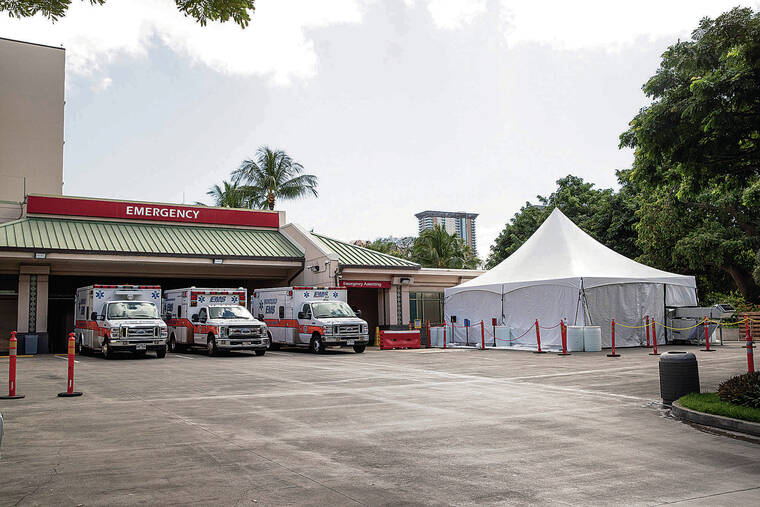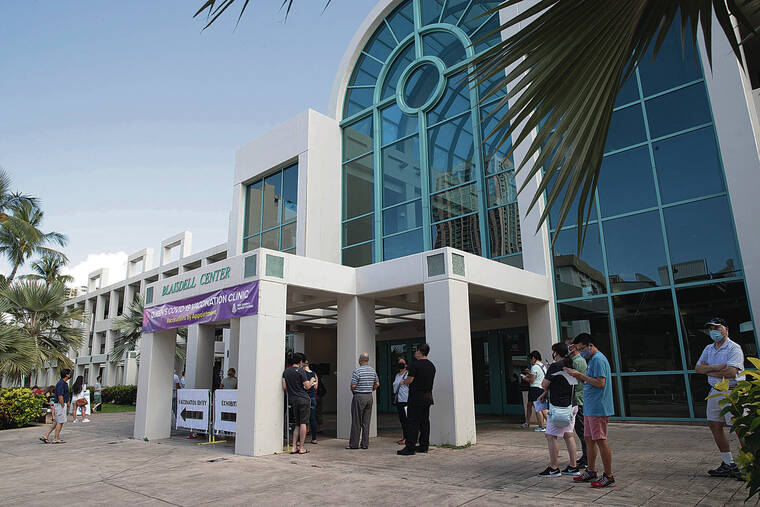The head of the Healthcare Association of Hawaii said it’s critical that the Federal Emergency Management Agency approves an urgent request to send 700 supplemental health care workers to Hawaii in three waves starting Jan. 10.
Hilton Raethel, Healthcare Association of Hawaii president and CEO, told the Honolulu Star-Advertiser on Monday that more health care staffing is needed so Hawaii can manage the additional strain that the rapid spread of the omicron variant is putting on a system nearly at capacity.
Hawaii’s hospitalizations have climbed more slowly with the highly contagious omicron than with the delta variant. However, omicron is spreading fast through Hawaii, where even a fully vaccinated and boosted Hawaii County Mayor Mitch Roth and U.S. Congressman Kai Kahele tested positive over the Christmas weekend.
Hawaii Department of Health officials reported 1,384 new confirmed and probable coronavirus infections Monday, bringing the state’s total since the start of the pandemic to 103,773 cases. No new virus-related fatalities were reported Monday so the statewide COVID-19 death toll remains 1,082. The U.S. coronavirus- related death toll Monday was over 809,000 and the nationwide infection tally was more than 51.6 million.
Health officials also said Monday that, of the state’s total infection count, 13,966 cases were considered to be active. Officials say they consider infections reported in the past 14 days to be a “proxy number for active cases.”
The state’s total number of active cases increased Monday by 1,189.
Raethel said the numbers are picking up at a time when Hawaii’s hospital census is already high and the system is down by hundreds of workers. There’s also a risk that Hawaii could lose some of its National Guard health care workers to more needy states in the coming weeks as part of President Joe Biden’s plan to have the military deploy health care personnel to alleviate staffing shortages.
“We already have full hospitals and we’ve got a worker shortage because we’ve got hundreds of people out exposed or positive and we’ve got another potential wave coming,” he said. “We could lose military personnel that we need.”
Raethel said the Hawaii Healthcare Association, along with the state Department of Health and the Hawaii Emergency Management Agency, began the formal process to request FEMA support last week.
“The sooner we get the green light, the better off we are,” he said.
Lt. Gov. Josh Green said there were 100 COVID patients in Hawaii hospitals on Monday. That’s up from just 34 on Dec. 13.
Raethel said it’s more difficult for Hawaii’s hospitals to handle the rise in COVID-19 hospitalizations during this surge because the hospital census is almost at 2,200, which is higher than normal. Over the last six months to a year, he said people have gotten sicker for a variety of reasons, including the decision to delay health care during the pandemic.
Raethel said another 100 to 150 COVID-19 hospitalizations, which could come very early in the new year, would be enough to reach the tipping point if Hawaii hospitals aren’t able to staff up for this surge.
“We think we are OK this week,” he said. “It will continue to climb this week and where it’s going to get very concerning is starting next week.”
Raethel said Hawaii’s total hospital census peaked at 2,365, including 404 COVID- 19 patients, during the delta surge this summer, but at that time Hawaii had 700 supplemental health care workers from the mainland.
“That’s how many health care workers it took in addition to our own staff to take care of all of those patients,” he said. “At that point in time, we didn’t have quite as many health care workers out. The staff outages are materially higher for this surge than they were for the delta surge.”
Raethel said Hawaii has kept around 200 of the surge workers who were sent here during delta, although the FEMA funding to cover them ended on Nov. 13.
But they haven’t quite made up for the several hundred of Hawaii’s health care workers, particularly on Oahu, who are out of work either because they have gotten COVID-19 or experienced a close exposure.
Those absences are only adding to previous staffing shortages.
Raethel said Hawaii’s pre-pandemic hospital staffing was already short by up to 12% heading into the pandemic.
Raethel said COVID-19 vaccination rates are high among Hawaii’s health care workers; however, he said it’s not known how many have been boosted.
Green said 74% of Hawaii is fully vaccinated; however, only 339,457 boosters have been given across the state.
“Omicron requires boosters to stop it from producing symptomatic disease,” said Green, who is pushing for a mass booster and testing site in each county.
“It must happen,” he said. “Most hospitals should be encouraged regionally to have a tent for this. The state or FEMA should provide the resources.”
Roth, who is in COVID-19 quarantine, also emphasized the importance of coronavirus booster shots.
“With the rise in cases happening across our state and on our island, we all need to do what we can to ensure that we can protect ourselves and those around us,” Roth said in a news release. “Getting vaccinated and, most importantly, getting boosted can minimize the chance of severe illness and keep us out of the hospitals. I’m only experiencing minor symptoms because of the vaccines, and I would like to encourage all of you who haven’t gotten yours yet to please go ahead and do so. The virus is spreading at a rampant rate and will take a toll on our medical resources if we don’t all do our part. The power is really in our hands, and we have to take this seriously.”
Raethel said Hawaii is in a race to shore up staffing resources, but FEMA has assured him that there are adequate resources to help Hawaii for a third time.
“Hawaii is a small state of 1.4 million people so our request for staffing is much lower and easier to fill,” he said.
However, it’s not a trivial request, he said.
“What we spent last go-round was approximately $80 million,” he said, adding that federal money is needed to bring surge staffing to Hawaii since the state has already said that it doesn’t have enough money to pay for it.




